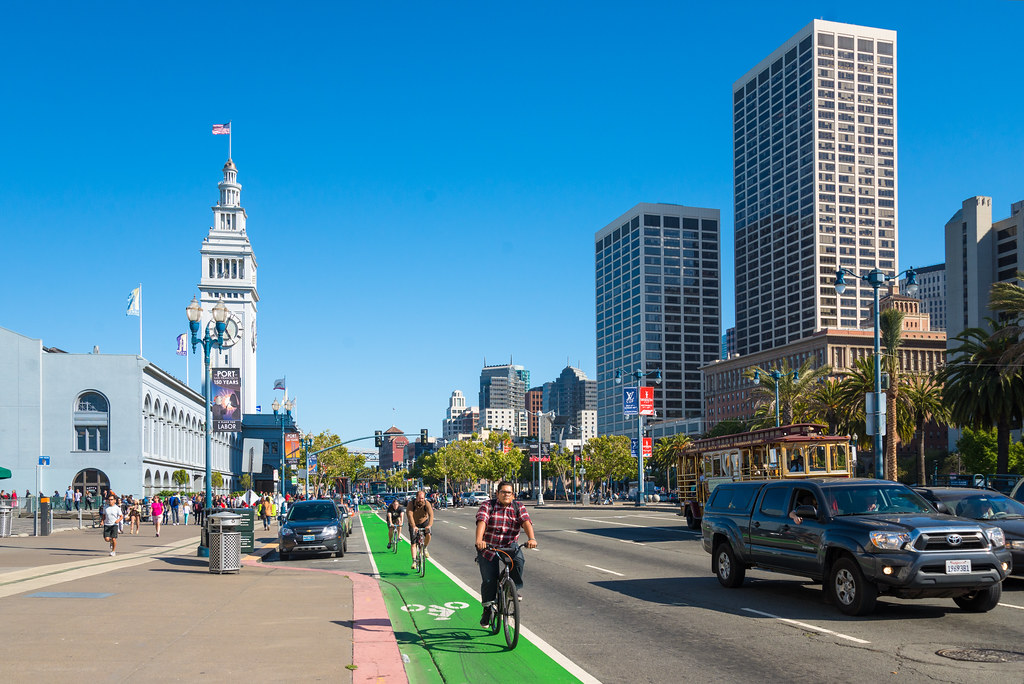For those who dream of better transportation options on San Francisco's streets, which were engineered in the 20th century to maximize space for cars at the expense of safety and efficient transit, the lack of city leadership on two recent major re-design projects has been troubling.
The concessions offered by city planners and politicians will probably do little to appease the parking-obsessed merchant groups fighting upgrades on Polk Street and Geary Boulevard. But they will mean that Polk won't feel safe enough for most San Franciscans to try biking there, and that Geary won't provide the kind of world-class transit service that the city needs on its surface streets.
For city leaders like Supervisor David Chiu, finding a position somewhere between sound, evidence-based transportation policy and those who simply yell the loudest is appealing because it's considered a "compromise." To them, the point isn't to make city streets as safe as they should be, or to make transit more appealing than driving -- it's to avoid upsetting anyone too much.
That's how Chuck Nevius described the Polk situation in his SF Chronicle column last week. "Both sides get some of what they want and think the other camp is getting too much," he wrote:
The ongoing controversy over bike traffic along Polk Street will probably never be solved to the satisfaction of everyone. But there are signs of progress.
Polk is a primary north-south route to and from the Marina for cyclists, has a relatively gentle slope and isn't as clogged with high-speed traffic as nearby Van Ness. Bicyclists wanted two separated lanes on both sides of the street, but merchants complained that the plan would wipe out too much parking and kill business.
The problem with framing the current Polk proposal -- which includes one stretch of protected bike lane and many more blocks that don't fundamentally alter the dangerous, car-centric status quo -- as the "middle ground" is that the group opposing safety improvements has staked out a position so opposed to change that the plan is far from the people-friendly, bike-friendly street the SFMTA originally set out to create.
The merchants with a cars-first mentality have simply disregarded empirical evidence, like the survey showing that 83 percent of people arrive on Polk without a car. They don't believe that improving bicycling conditions on the street would encourage more San Franciscans to shop by bike, or that taming car traffic draws more foot traffic. When it comes to reducing the number of pedestrian and bike crashes on Polk -- two per month -- the typical response from this camp has been to blame the victim. One merchant even tried to stop Streetsblog from filming the street out of fear that it might cast a sympathetic light on one of those victims.
It's a similar situation on Geary, where a new option proposed for the Bus Rapid Transit line would forgo bus passing lanes that make it possible to operate both local and express service. In essence, it's a watered-down version of the original proposal, designed to sacrifice transit speeds and choices to preserve all car parking. This comes despite a survey showing that 78 percent of customers on Geary arrive without a car, and that improving Muni service is their highest transportation priority.
If San Francisco has learned anything from its recent transportation history, it should be that the greatest successes come with bold changes, not half-measures.
Just imagine if Mayor Art Agnos backed down on removing the Embarcadero Freeway. In the northern Mission, where a section of the Central Freeway was rebuilt as a "compromise" with Caltrans and pro-freeway constituents in the Avenues, the neighborhood remains blighted by the structure, while neighboring Hayes Valley thrived after its section of the freeway was taken down. Both of those freeway removals were the result of fierce political battles.
Years down the road, leaders like Agnos owe their legacy to how far they went, not how much they backed down to the naysayers.
Those complaints may never stop, no matter how much the city retreats from its plans in the attempt to make everyone happy. Even in Vancouver -- a city that has reduced car traffic even as its population has grown in recent decades -- complaints continue to surface about new initiatives to reallocate street space from cars to other modes. In Vancouver, though, decision makers tend to follow through and move forward with 21st-century transportation projects.
If San Francisco's political leaders continue to take a position somewhere between sound transportation policy and appeasing merchants who insist on shooting themselves in the foot with a cars-first stance, our city won't overcome the transportation mistakes we made in the 20th century.





